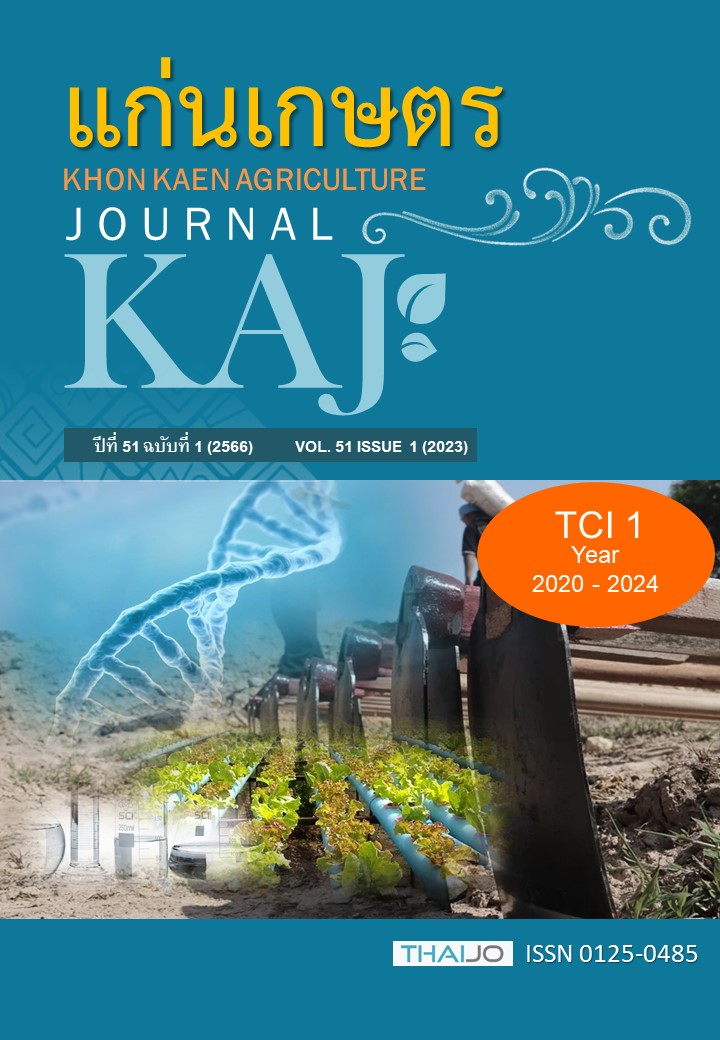Effects of season, female:male row ratio and plant spacing on agronomic characteristics and yield of field corn hybrid
Main Article Content
Abstract
High yield of field corn hybrid production depend on season, female:male row ratio and plant spacing etc. Therefore, the objective of this study was to evaluate the effects of season, female:male row ratio and plant spacing on agronomic characteristics and yield of a new field corn hybrid cv. Suwan 5720 (Ki61 x Ki60). This study was conducted at National Corn and Sorghum Research Center in 3 seasons; 1) dry season 2020 2) early rainy season 2021 and 3) late rainy season 2021. The experiment was arranged in split-plot in randomized complete block design (RCBD) with 4 replications. Two plant spacings; 60 x 20 and 70 x 20 cm were main plot and two levels of female:male row ratio; 4:1 and 6:2 were sub-plot. The results showed that late rainy season had early 50% tasselling and silking and higher plant and ear height than grown in early rainy and dry season. Early rainy season had the highest ear yield/rai, whereas seed yield/rai did not significantly different to late rainy and dry season. Plant spacing of 60 x 20 cm showed higher plant and ear height, number of harvested plant/rai and ear/rai and seed yield than those of 70 x 20 cm. No interaction among planting season, spacing and female:male ratio were found on seed yield/rai. It indicates that seed production of field corn hybrid cv. Suwan 5720 in late rainy season at female:male row ratio of 4:1 and plant spacing of 60 x 20 cm gave higher seed yield, good ear weight and shelling percentage than other season, female:male row ratio and plant spacing.
Article Details

This work is licensed under a Creative Commons Attribution-NonCommercial-NoDerivatives 4.0 International License.
References
เกรียงศักดิ์ สุวรรณธราดล. 2535. ข้อพิจารณาบางประการในการเปลี่ยนแปลงฤดูปลูกข้าวโพด, น. 1-13. ใน เอกสารประกอบการบรรยายในการประชุมวิชาการข้าวโพดข้าวฟ่างแห่งชาติ ครั้งที่ 23. ณ โรงแรมแกรนด์จอมเทียนพาเลซ พัทยา, ชลบุรี.
เกรียงศักดิ์ สุวรรณธราดล, พาโชค พงษ์พานิช และสรรเสริญ จำปาทอง. 2555. สามทศวรรษของธุรกิจเมล็ดพันธุ์ข้าวโพดไร่ลูกผสมในประเทศไทย. แก่นเกษตร. 40 (4): 16-30.
ชูศักดิ์ จอมพุก, สรรเสริญ จำปาทอง, กิตติ บุญเลิศนิรันดร์, พีรนุช จอมพุก, จุฑามาศ ร่มแก้ว และชเนษฎ์ ม้าลำพอง. 2561. การพัฒนาพันธุ์ข้าวโพดไร่ลูกผสมเพื่อปลูกในดินนาฤดูแล้งเขตชลประทานภาคกลาง. รายงานการวิจัยการพัฒนาการวิจัยการเกษตร ฉบับสมบูรณ์ เสนอ สำนักงานพัฒนาการวิจัยการเกษตร (องค์การมหาชน). 98 หน้า.
สำนักงานเศรษฐกิจการเกษตร. 2563. ข้อมูลการผลิตสินค้าเกษตร: ข้าวโพดเลี้ยงสัตว์. แหล่งข้อมูล: http://www.oae.go.th/view/, 25 พฤษภาคม 2563.
ศิรประภา นาสารีย์. 2558. คุณภาพของเมล็ดพันธุ์ข้าวโพดไร่และข้าวโพดฝักอ่อนลูกผสมที่เก็บรักษาที่ห้องควบคุมอุณหภูมิและความชื้นสัมพัทธ์และอุณหภูมิห้อง. วิทยานิพนธ์วิทยาศาสตรมหาบัณฑิต, มหาวิทยาลัยเกษตรศาสตร์.
ราเชนทร์ ถิรพร. 2539. ข้าวโพด. ภาควิชาพืชไร่นา มหาวิทยาลัยเกษตรศาสตร์, กรุงเทพฯ. 274 หน้า.
เอ็จ สโรบล, สุรพล เช้าฉ้อง, สดใส ช่างสลัก, ศุภกาญจน์ ล้วนมณี, รวีวรรณ เชื้อกิตติศักดิ์, จุฑามาศ ร่มแก้ว, สราวุธ รุ่งเมฆารัตน์ และสุพจน์ กาเซ็ม. 2560. ใน รายงาน ความก้าวหน้าโครงการวิจัยศักยภาพการให้ผลผลิตของพันธุ์ข้าวโพดไร่ลูกผสมภายใต้ วิธีการเพาะปลูกแบบปกติและการลดการไถพรวนในฤดูฝนและฤดูแล้ง ครั้งที่ 3. สํานักงาน พัฒนาการวิจัยการเกษตร (องค์การมหาชน), กรุงเทพฯ. 245 หน้า.
Belay, M.K. 2019. Effect of inter and intra row spacing on growth, yield components and yield of hybrid maize (Zea mays L.) varieties at Haramaya, Eastern Ethiopia. American Journal of Plant Sciences. 10: 1548-1564.
Boomsma, C.R., J.B. Santini, M. Tollenaar, and T.J. Vyn. 2009. Maize morphophysiological responses to intense crowding and low nitrogen availability: An analysis and review. Agronomy Journal. 101: 1426–1452.
Borras, L., M.E. Westgate, and M.E. Otegui. 2003. Control of kernel weight and kernel water relations by the post-flowering source-sink ratio in maize. Annals of Botany. 91: 857-886.
Douglas, A., C.B. Dyson, and D.P. Sinclair. 1982. Effect of plant population on the yield of maize under high yielding conditions in New Zealand. New Zealand Journal Agricultural Research. 25: 147-149.
Fadhly, A.F., S. Saenong, R. Arief, F. Tabri, and F. Koes. 2010. Perakitan Teknologi Produksi Benih Jagung Hibrida Berumur Sedang (90-100 hari, hasil benih F1>2 t/ha). Laporan Akhir Program Insentif Riset Terapan. Maros: Balai Penelitian Tanaman Serealia.
Jettner, R., S.P. Loss, K.H. Siddique, and L.D. Martin. 1998. Responses of faba bean (Vicia faba L.) to sowing rate in South-Western Australia. I. Seed yield and economic optimum plant density. Australian Journal of Agricultural Research. 49: 989-998.
Jithendra, D.B., G.V. Basvaraju, G. Sarika, and N. Amrutha. 2013. Effect of fertilizer levels and planting geometry on growth and seed yield of single cross maize hybrid NAH-2049 (Nithyashree). Global Journal of Biology, Agriculture and Health Science. 2(3): 216-220.
R Core Team. 2020. The R Project for Statistical Computing. Available Source:
http://www.r-project.org/index.html, January 20, 2020.
Raymond, F.D., M.M. Alley, D.J. Parrish, and W.E. Thomason. 2009. Plant density and hybrid impacts on corn grain and forage yield and nutrient uptake. Journal of Plant Nutrition. 32: 395–409.
Ridwan, I., M. Farid Bdr, Y. Musa, H. Jamil, A.R. Amin, M.F. Anshori, S. Pati, N. Nursini, and A.N. Fadhilah. 2020. SINHAS-1 maize seed production through male-female ratio and pruning technique. Agrotech Journal. 5(2): 73-81.
Sárvári, M., Z. Futó, and M. Zsoldos. 2002. A vetésido? és a to?szám hatása a kukorica termésére. 51(3): 291-307.
Shapiro, C.A., and C.S. Wortmann. 2006. Corn response to nitrogen rate, row spacing, and plant density in eastern Nebraska. Agronomy Journal. 98: 529–535.
Stanger, T.F., and J.G. Lauer. 2007. Corn stalk response to plant population and the Bt-European corn borer trait. Agronomy Journal. 99: 657–664.
Tolka, A. 2014. Effect of variaties and plant density on yield and yield components of maize (Zea mays L.) in Ofa District, Gesuba, southern Ethiopia. Hara-maya University, Haramaya, Ethiopia.
Tollenaar, M., and F.A. Lee. 2002. Yield potential, yield stability and stress tolerance in maize. Field Crops Research. 75: 161–169.
Yuyun, I., and R.A. Syahban. 2017. The ratio of male and female parental and addition boron fertilizer in male plant to the production and quality seed of sweet corn (Zea mays “saccharata” STURT). Agriprima: Journal of Applied Agricultural Sciences. 1 (1): 1-12.

